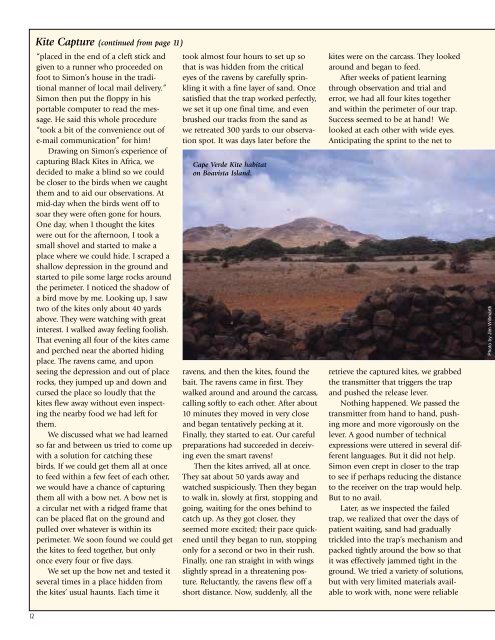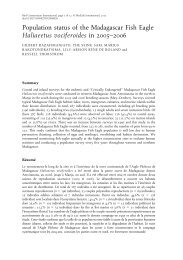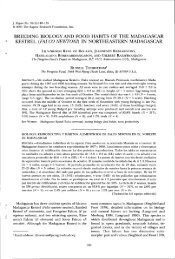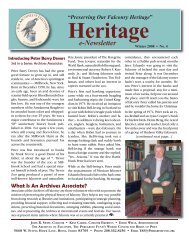2001 Newsletter - The Peregrine Fund
2001 Newsletter - The Peregrine Fund
2001 Newsletter - The Peregrine Fund
Create successful ePaper yourself
Turn your PDF publications into a flip-book with our unique Google optimized e-Paper software.
12<br />
Kite Capture (continued from page 11)<br />
“placed in the end of a cleft stick and<br />
given to a runner who proceeded on<br />
foot to Simon’s house in the traditional<br />
manner of local mail delivery.”<br />
Simon then put the floppy in his<br />
portable computer to read the message.<br />
He said this whole procedure<br />
“took a bit of the convenience out of<br />
e-mail communication” for him!<br />
Drawing on Simon’s experience of<br />
capturing Black Kites in Africa, we<br />
decided to make a blind so we could<br />
be closer to the birds when we caught<br />
them and to aid our observations. At<br />
mid-day when the birds went off to<br />
soar they were often gone for hours.<br />
One day, when I thought the kites<br />
were out for the afternoon, I took a<br />
small shovel and started to make a<br />
place where we could hide. I scraped a<br />
shallow depression in the ground and<br />
started to pile some large rocks around<br />
the perimeter. I noticed the shadow of<br />
a bird move by me. Looking up, I saw<br />
two of the kites only about 40 yards<br />
above. <strong>The</strong>y were watching with great<br />
interest. I walked away feeling foolish.<br />
That evening all four of the kites came<br />
and perched near the aborted hiding<br />
place. <strong>The</strong> ravens came, and upon<br />
seeing the depression and out of place<br />
rocks, they jumped up and down and<br />
cursed the place so loudly that the<br />
kites flew away without even inspecting<br />
the nearby food we had left for<br />
them.<br />
We discussed what we had learned<br />
so far and between us tried to come up<br />
with a solution for catching these<br />
birds. If we could get them all at once<br />
to feed within a few feet of each other,<br />
we would have a chance of capturing<br />
them all with a bow net. A bow net is<br />
a circular net with a ridged frame that<br />
can be placed flat on the ground and<br />
pulled over whatever is within its<br />
perimeter. We soon found we could get<br />
the kites to feed together, but only<br />
once every four or five days.<br />
We set up the bow net and tested it<br />
several times in a place hidden from<br />
the kites’ usual haunts. Each time it<br />
took almost four hours to set up so<br />
that is was hidden from the critical<br />
eyes of the ravens by carefully sprinkling<br />
it with a fine layer of sand. Once<br />
satisfied that the trap worked perfectly,<br />
we set it up one final time, and even<br />
brushed our tracks from the sand as<br />
we retreated 300 yards to our observation<br />
spot. It was days later before the<br />
Cape Verde Kite habitat<br />
on Boavista Island.<br />
ravens, and then the kites, found the<br />
bait. <strong>The</strong> ravens came in first. <strong>The</strong>y<br />
walked around and around the carcass,<br />
calling softly to each other. After about<br />
10 minutes they moved in very close<br />
and began tentatively pecking at it.<br />
Finally, they started to eat. Our careful<br />
preparations had succeeded in deceiving<br />
even the smart ravens!<br />
<strong>The</strong>n the kites arrived, all at once.<br />
<strong>The</strong>y sat about 50 yards away and<br />
watched suspiciously. <strong>The</strong>n they began<br />
to walk in, slowly at first, stopping and<br />
going, waiting for the ones behind to<br />
catch up. As they got closer, they<br />
seemed more excited; their pace quickened<br />
until they began to run, stopping<br />
only for a second or two in their rush.<br />
Finally, one ran straight in with wings<br />
slightly spread in a threatening posture.<br />
Reluctantly, the ravens flew off a<br />
short distance. Now, suddenly, all the<br />
kites were on the carcass. <strong>The</strong>y looked<br />
around and began to feed.<br />
After weeks of patient learning<br />
through observation and trial and<br />
error, we had all four kites together<br />
and within the perimeter of our trap.<br />
Success seemed to be at hand! We<br />
looked at each other with wide eyes.<br />
Anticipating the sprint to the net to<br />
retrieve the captured kites, we grabbed<br />
the transmitter that triggers the trap<br />
and pushed the release lever.<br />
Nothing happened. We passed the<br />
transmitter from hand to hand, pushing<br />
more and more vigorously on the<br />
lever. A good number of technical<br />
expressions were uttered in several different<br />
languages. But it did not help.<br />
Simon even crept in closer to the trap<br />
to see if perhaps reducing the distance<br />
to the receiver on the trap would help.<br />
But to no avail.<br />
Later, as we inspected the failed<br />
trap, we realized that over the days of<br />
patient waiting, sand had gradually<br />
trickled into the trap’s mechanism and<br />
packed tightly around the bow so that<br />
it was effectively jammed tight in the<br />
ground. We tried a variety of solutions,<br />
but with very limited materials available<br />
to work with, none were reliable<br />
Photo by Jim Willmarth

















